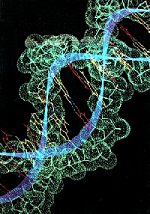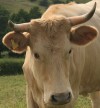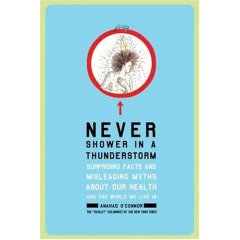Almost ten years ago, I wrote a feature article on the cancer risk associated with the bracken toxins known as ptaquiloside for ChemWeb. The article was updated and mirrored on Paul May’s Molecule of the Month website at Bristol University, and quite bizarrely still draws a few readers to the Sciencebase site via my byline on the article. I suppose the reason it is still popular is that it makes it to page on in Google should you search for the word bracken.
Anyway, this article occasionally triggers some rather interesting correspondence with readers. Most recently, John Nayler emailed me to ask whether or not toxic chemicals from bracken might leach into groundwater beneath bracken-infested areas. I had to admit I did not know, but a paper published recently in the journal Chemosphere (2007, 67, 202-209) discusses the microbial degradation and impact of ptaquiloside on soil microbes themselves, which sheds some light on the potential impact of this carcinogenic toxin.
Another of Nayler’s concerns regards whether or not bracken is not simply an unpleasant weed with a cancer risk associated with eating the “fiddle heads” (a delicacy in Japan), but whether or not landowners, whose land is infested with bracken might be liable for public health lawsuits should those with a right to roam on their land be exposed to bracken spores. The risk may be small but that never stopped an ambulance-chasing lawyer in the past.
Cancer Research UK has a FAQ on the cancer potential of bracken. Despite isolated ptaquiloside coming up positive in carcinogenicity tests a decade ago, the latest research, according to Cancer UK is that there is no risk of cancer associated with eating bracken fiddlehead greens. So, what about those spores. Studies have shown bracken spores to cause cancer in mice, but those mice were given a lot of spores and to extrapolate to human cancer risk is (death)wishful thinking. A walk among the bracken is more likely to trigger a sneezing fit if the spores are high than anything else, and as CRUK points out, diet and smoking are far greater risk factors than bracken for cancer.
 The budget for the Human Genome Project and all that post-genomic, proteomic, metabonomic, immunomic…research was almost on a par with defense spending; it was almost c-omical really. Well, maybe not quite, but it stretches out with a lot of zeros nevertheless. At the time the grants were written and the funding given, we, as a society, were promised all kinds of medical miracles from gene therapies and new treatments to cure all those nasties – cystic fibrosis, sickle cell, thalassemia, cancer, heart disease and more.
The budget for the Human Genome Project and all that post-genomic, proteomic, metabonomic, immunomic…research was almost on a par with defense spending; it was almost c-omical really. Well, maybe not quite, but it stretches out with a lot of zeros nevertheless. At the time the grants were written and the funding given, we, as a society, were promised all kinds of medical miracles from gene therapies and new treatments to cure all those nasties – cystic fibrosis, sickle cell, thalassemia, cancer, heart disease and more. Scientists in New Zealand hope to breed cows to produce low-fat, skimmed milk, not only that they are working on a new bovine breed that will produce milk that makes spreadable butter.
Scientists in New Zealand hope to breed cows to produce low-fat, skimmed milk, not only that they are working on a new bovine breed that will produce milk that makes spreadable butter. This item could have been called “How to out-psyche yourself”, it is not exactly rocket science, but then rocket science is not one of the common topics on Sciencebase, anyway. It’s a public holiday here, today. Yes, I know…again? Oh, and over there too? Anyway, I’ve pulled together some of the chillingest out posts from the last week or so and brought them together in an easy to catch, laid back post with few words, and a hammock on stand by in case the sun comes out. Incidentally, almost all these tips, or life-hacks as some people are wont to call them basically boil down to a simple phrase, that any analyst, physician, or psychiatrist could do well to hang on their surgery door, desk, and above their sphigmomanometer – Don’t Worry, Be Happy.
This item could have been called “How to out-psyche yourself”, it is not exactly rocket science, but then rocket science is not one of the common topics on Sciencebase, anyway. It’s a public holiday here, today. Yes, I know…again? Oh, and over there too? Anyway, I’ve pulled together some of the chillingest out posts from the last week or so and brought them together in an easy to catch, laid back post with few words, and a hammock on stand by in case the sun comes out. Incidentally, almost all these tips, or life-hacks as some people are wont to call them basically boil down to a simple phrase, that any analyst, physician, or psychiatrist could do well to hang on their surgery door, desk, and above their sphigmomanometer – Don’t Worry, Be Happy. The Independent on Sunday today reports that a UK researcher is claiming that
The Independent on Sunday today reports that a UK researcher is claiming that  Could those so-called “bio” yogurts and milk-type drinks with Scandinavian sounding names actually do you any good? Possibly.
Could those so-called “bio” yogurts and milk-type drinks with Scandinavian sounding names actually do you any good? Possibly. I just received an early publication alert from the Australian research organisation CSIRO announcing the imminent publication of volume 19 of their journal on reproductive science, fascinating I thought as I opened the attachment.
I just received an early publication alert from the Australian research organisation CSIRO announcing the imminent publication of volume 19 of their journal on reproductive science, fascinating I thought as I opened the attachment. NYT reporter Anahad O’Connor sent me a review copy of his latest book, “Never shower in a thunderstorm”, which hits bookshelves in paperback this week. In it, O’Conner debunks, in the style of his regular “Really?” column, numerous health myths and misconceptions such as whether
NYT reporter Anahad O’Connor sent me a review copy of his latest book, “Never shower in a thunderstorm”, which hits bookshelves in paperback this week. In it, O’Conner debunks, in the style of his regular “Really?” column, numerous health myths and misconceptions such as whether  In chemistry news this week, The Alchemist learns about slow-release drug formulations that prevent drug abuse, the risks of war associated with using depleted uranium in munitions and armour plating, and the analytical benefits of red wine that could turn up on labels to guide consumers to the most healthful Chianti or Zindanfel.
In chemistry news this week, The Alchemist learns about slow-release drug formulations that prevent drug abuse, the risks of war associated with using depleted uranium in munitions and armour plating, and the analytical benefits of red wine that could turn up on labels to guide consumers to the most healthful Chianti or Zindanfel.